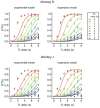Valuation of uncertain and delayed rewards in primate prefrontal cortex
- PMID: 19375276
- PMCID: PMC2693219
- DOI: 10.1016/j.neunet.2009.03.010
Valuation of uncertain and delayed rewards in primate prefrontal cortex
Abstract
Humans and animals often must choose between rewards that differ in their qualities, magnitudes, immediacy, and likelihood, and must estimate these multiple reward parameters from their experience. However, the neural basis for such complex decision making is not well understood. To understand the role of the primate prefrontal cortex in determining the subjective value of delayed or uncertain reward, we examined the activity of individual prefrontal neurons during an inter-temporal choice task and a computer-simulated competitive game. Consistent with the findings from previous studies in humans and other animals, the monkey's behaviors during inter-temporal choice were well accounted for by a hyperbolic discount function. In addition, the activity of many neurons in the lateral prefrontal cortex reflected the signals related to the magnitude and delay of the reward expected from a particular action, and often encoded the difference in temporally discounted values that predicted the animal's choice. During a computerized matching pennies game, the animals approximated the optimal strategy, known as Nash equilibrium, using a reinforcement learning algorithm. We also found that many neurons in the lateral prefrontal cortex conveyed the signals related to the animal's previous choices and their outcomes, suggesting that this cortical area might play an important role in forming associations between actions and their outcomes. These results show that the primate lateral prefrontal cortex plays a central role in estimating the values of alternative actions based on multiple sources of information.
Figures









Similar articles
-
Dynamic signals related to choices and outcomes in the dorsolateral prefrontal cortex.Cereb Cortex. 2007 Sep;17 Suppl 1:i110-7. doi: 10.1093/cercor/bhm064. Epub 2007 Jun 4. Cereb Cortex. 2007. PMID: 17548802
-
Mechanisms of reinforcement learning and decision making in the primate dorsolateral prefrontal cortex.Ann N Y Acad Sci. 2007 May;1104:108-22. doi: 10.1196/annals.1390.007. Epub 2007 Mar 8. Ann N Y Acad Sci. 2007. PMID: 17347332 Review.
-
Cortical mechanisms for reinforcement learning in competitive games.Philos Trans R Soc Lond B Biol Sci. 2008 Dec 12;363(1511):3845-57. doi: 10.1098/rstb.2008.0158. Philos Trans R Soc Lond B Biol Sci. 2008. PMID: 18829430 Free PMC article.
-
Reward-dependent learning in neuronal networks for planning and decision making.Prog Brain Res. 2000;126:217-29. doi: 10.1016/S0079-6123(00)26016-0. Prog Brain Res. 2000. PMID: 11105649 Review.
-
[Neural mechanisms of decision making].Brain Nerve. 2008 Sep;60(9):1017-27. Brain Nerve. 2008. PMID: 18807936 Review. Japanese.
Cited by
-
From habits to self-regulation: how do we change?Yale J Biol Med. 2012 Jun;85(2):293-9. Epub 2012 Jun 25. Yale J Biol Med. 2012. PMID: 22737058 Free PMC article.
-
Heterogeneous coding of temporally discounted values in the dorsal and ventral striatum during intertemporal choice.Neuron. 2011 Jan 13;69(1):170-82. doi: 10.1016/j.neuron.2010.11.041. Neuron. 2011. PMID: 21220107 Free PMC article.
-
Selective chemogenetic inactivation of corticoaccumbal projections disrupts trait choice impulsivity.Neuropsychopharmacology. 2023 Nov;48(12):1821-1831. doi: 10.1038/s41386-023-01604-5. Epub 2023 May 19. Neuropsychopharmacology. 2023. PMID: 37208501 Free PMC article.
-
Lateral intraparietal cortex and reinforcement learning during a mixed-strategy game.J Neurosci. 2009 Jun 3;29(22):7278-89. doi: 10.1523/JNEUROSCI.1479-09.2009. J Neurosci. 2009. PMID: 19494150 Free PMC article.
-
Early commitment facilitates optimal choice by pigeons.Psychon Bull Rev. 2017 Jun;24(3):957-963. doi: 10.3758/s13423-016-1173-8. Psychon Bull Rev. 2017. PMID: 27743217
References
-
- Ainslie G, Herrnstein RJ. Preference reversal and delayed reinforcement. Animal Learning & Behavior. 1981;9:476–482.
-
- Barraclough DJ, Conroy ML, Lee D. Prefrontal cortex and decision making in a mixed-strategy game. Nature Neuroscience. 2004;7:404–410. - PubMed
-
- Berns GS, Laibson D, Loewenstein G. Intertemporal choice - towards an integrative framework. Trends in Cognitive Science. 2007;11:482–488. - PubMed
Publication types
MeSH terms
Grants and funding
LinkOut - more resources
Full Text Sources

